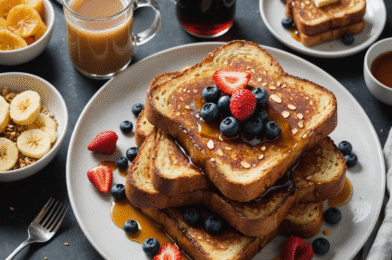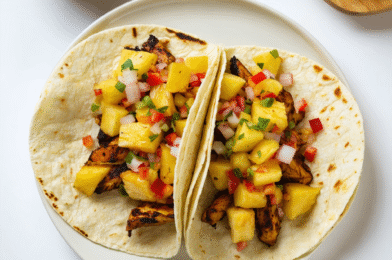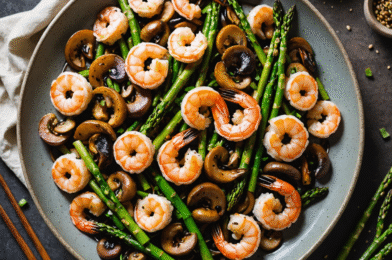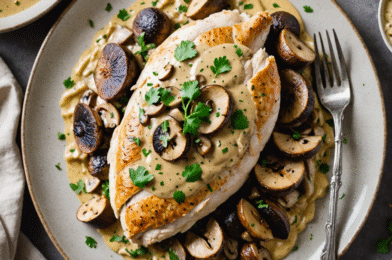Cream Cheese Lemonade Pie
Cream Cheese Lemonade Pie is a delectable fusion of creamy cheese and zesty lemon, making it a perfect dessert for any occasion. Whether you're hosting a summer party or craving a sweet treat, this pie offers a refreshing twist.
(Source: USDA)
Why You’ll Love This
This pie is loved for its ease of preparation and the delightful contrast of creamy and tangy flavors. It's an ideal dessert to impress guests without spending too much time in the kitchen.
Servings: 8 Prep: 20 min Cook: 10 min Total: 240 min Calories/serving (approx.): 320
Ingredients
- 1 1/2 cups (150g) graham cracker crumbs
- 1/3 cup (75g) melted butter
- 1/4 cup (50g) granulated sugar
- 1 package (8 oz or 225g) cream cheese, softened
- 1 can (14 oz or 400g) sweetened condensed milk
- 3/4 cup (180ml) frozen lemonade concentrate, thawed
- 1 teaspoon vanilla extract
- 1 tablespoon lemon zest
- 1 cup (240ml) heavy whipping cream
- 2 tablespoons powdered sugar
- 1/2 teaspoon cream of tartar
- Fresh lemon slices for garnish
- Mint leaves for garnish
- 1/4 teaspoon salt
- 1/2 teaspoon lemon extract (optional)
- 2 tablespoons cornstarch
- 1 tablespoon lemon juice
- 1 tablespoon water
Ingredient Notes (What & Why)
- Ensure the cream cheese is softened to avoid lumps in the filling. (Source: FDA)
- Use freshly zested lemon for the best aroma and flavor. (Source: BBC Good Food)
- Thaw the lemonade concentrate in the refrigerator for even mixing. (Source: Serious Eats)
Equipment
- 9-inch pie pan
- Mixing bowls
- Electric mixer
- Spatula
- Measuring cups and spoons
- Saucepan
- Whisk
- Refrigerator
- Oven
- Food processor
Timing & Temperature Guide
- Preheat oven to 350°F (175°C) for baking the crust.
- Chill the pie for at least 3 hours in the refrigerator to set.
- Allow the glaze to reach a bubbling point before removing from heat.
- Ensure cream cheese is at room temperature for smooth mixing.
- Whip cream until stiff peaks form, approximately 5–7 minutes.
- Bake crust for 10 minutes, then cool completely before adding filling.
- Filling should thicken slightly at room temperature before chilling.
- Lemon glaze should be translucent and thickened before application.
Step-by-step Instructions
- Preheat your oven to 350°F (175°C). (Source: Bon Appétit)
- In a medium bowl, combine graham cracker crumbs, melted butter, and granulated sugar until well mixed. (Source: NYT Cooking)
- Press the mixture firmly into the bottom and up the sides of a 9-inch pie pan. (Source: King Arthur Baking)
- Bake the crust for 10 minutes, then set aside to cool completely.
- In a large mixing bowl, beat the softened cream cheese until smooth.
- Gradually add the sweetened condensed milk, beating until well blended.
- Stir in the lemonade concentrate, vanilla extract, and lemon zest until the mixture is smooth and creamy.
- In a separate bowl, whip the heavy cream, powdered sugar, and cream of tartar until stiff peaks form.
- Gently fold the whipped cream into the lemon mixture, ensuring not to deflate the cream.
- Pour the filling into the cooled crust, smoothing the top with a spatula.
- Chill the pie in the refrigerator for at least 3 hours, or until set.
- For the glaze, combine lemon juice, water, and cornstarch in a small saucepan over medium heat. Stir until thickened.
- Allow the glaze to cool slightly, then spread over the chilled pie.
- Garnish with lemon slices and mint leaves before serving.
Culinary Science Notes
- The acidity of lemon juice helps to set the cream cheese mixture.
- Whipping cream incorporates air, providing a light, fluffy texture.
- Cornstarch acts as a thickening agent in the glaze, providing stability.
- The fat content in cream cheese adds richness and smoothness to the pie.
- Cooling the pie allows the proteins in the filling to set firmly.
- The Maillard reaction during crust baking enhances flavor and aroma.
- Cream of tartar stabilizes whipped cream, preventing it from deflating.
- The sugar in the filling helps to balance the acidity of the lemons.
Pro Tips
- For a stronger lemon flavor, add a few drops of lemon extract to the filling.
- Chill the pie overnight for the best texture and flavor.
- Use a food processor to finely crush graham crackers for a smoother crust.
- To prevent the crust from sticking, lightly grease the pie pan before pressing in the crumb mixture.
- Taste the filling before chilling; adjust sweetness by adding more powdered sugar if desired.
- If the filling is too soft after chilling, place the pie in the freezer for 30 minutes before serving.
- For a lighter version, substitute regular cream cheese with low-fat cream cheese.
- Ensure all ingredients are at room temperature for easier mixing.
- Use a serrated knife to cut the pie for cleaner slices.
- Store leftover pie in an airtight container to prevent it from absorbing odors in the fridge.
- Use a chilled bowl and beaters for whipping cream to achieve better volume.
- Try adding a pinch of salt to balance the sweetness and enhance the lemon flavor.
Variations
- Use a digestive biscuit base instead of graham crackers for a different texture.
- Add a layer of blueberry or raspberry compote over the filling for a fruity twist.
- Incorporate a swirl of lemon curd into the cream cheese mixture for added zest.
- For a tropical version, add a layer of coconut flakes on top of the pie.
- Replace lemonade concentrate with limeade concentrate for a lime-flavored pie.
- Include crushed nuts, such as almonds or pecans, in the crust for added crunch.
- Experiment with different citrus zests like orange or grapefruit for unique flavors.
- Use chocolate graham crackers for a chocolate-lemon combination.
- Add a layer of thinly sliced strawberries before pouring the filling for extra freshness.
- Drizzle melted white chocolate over the chilled pie for a decorative touch.
- Create a marbled effect by swirling in raspberry puree into the filling before chilling.
- Use a gluten-free graham cracker alternative to make the pie suitable for gluten-sensitive individuals.
Substitutions
- Substitute cream cheese with mascarpone for a richer flavor.
- Use coconut milk instead of heavy cream for a dairy-free version.
- Replace granulated sugar with honey for a natural sweetener.
- Opt for almond milk in place of sweetened condensed milk for a lower sugar option.
- Swap graham crackers with digestive biscuits for a different crust flavor.
- Use agave syrup instead of powdered sugar for a vegan-friendly sweetener.
- Try a mix of Greek yogurt and cream cheese for a tangier filling.
- Substitute butter with margarine for a non-dairy crust.
- Use lemon curd instead of lemonade concentrate for a more intense lemon flavor.
- Replace vanilla extract with almond extract for a nutty undertone.
- Opt for a sugar-free lemonade concentrate to reduce sugar content.
- Use a plant-based whipping cream for a vegan adaptation.
Dietary Adaptations
- For a gluten-free version, use gluten-free graham crackers.
- To make it vegan, replace cream cheese with a dairy-free alternative and use coconut cream.
- Use sugar substitutes like stevia for a low-sugar version.
- Substitute regular cream with lactose-free cream for lactose-intolerant individuals.
- Choose a nut-free crust option if catering to nut allergies.
- Incorporate chia seeds into the filling for added fiber.
- Use a soy-based condensed milk substitute for a soy-free option.
- Make a crustless version by simply chilling the filling in dessert cups.
Serving Suggestions & Menu Ideas
- Serve chilled with a dollop of whipped cream.
- Pair with a glass of iced tea for a refreshing combination.
- Garnish with fresh mint leaves for an aromatic touch.
- Add a scoop of vanilla ice cream for extra indulgence.
- Serve with fresh berries to complement the lemon flavor.
- Drizzle with raspberry sauce for a contrast in sweetness.
- Pair with a light white wine, such as a Sauvignon Blanc.
- Enjoy with a cup of herbal tea to balance the citrus notes.
- Serve with a side of lemon sorbet for a citrus overload.
- Top with candied lemon peel for a sweet, tangy finish.
Menu Ideas
- Include in a summer picnic spread with fresh salads and sandwiches.
- Serve as a light dessert following a seafood dinner.
- Pair with a brunch menu featuring quiche and fresh fruit.
- Include in a buffet with a variety of small desserts.
- Feature in a garden party menu with iced tea and finger foods.
- Serve at a baby shower alongside tea sandwiches and scones.
- Pair with a barbecue meal for a refreshing dessert option.
- Include in a holiday dessert table for a bright, citrusy contrast.
Seasonal Variations
- In summer, add fresh berries to the pie for extra freshness.
- In winter, serve with a warm lemon sauce for a comforting touch.
- In spring, pair with floral teas for a seasonal flair.
- In autumn, add a hint of cinnamon to the crust for warmth.
- Use seasonal fruits like kiwi or mango for a tropical version.
- Try a blood orange variation during citrus season for a unique twist.
- Add a dash of ginger to the filling for a winter spice note.
- Use Meyer lemons for a sweeter, less acidic pie in spring.
Troubleshooting & Common Mistakes
- If the filling is too runny, ensure the cream cheese is fully incorporated.
- For a crust that crumbles, press the crumbs firmly into the pan before baking.
- If the pie doesn’t set, chill for longer or place in the freezer briefly.
- Prevent a soggy crust by baking it until golden and allowing it to cool completely.
- If whipped cream deflates, ensure the bowl and beaters are chilled before whipping.
- Avoid lumps by bringing cream cheese to room temperature before mixing.
- If the glaze is too thick, add a little more water to reach the desired consistency.
- For a too-tart pie, add more sweetened condensed milk to balance the flavors.
- Ensure the pie is fully chilled before slicing to maintain clean cuts.
- If the pie is too sweet, add a touch of salt to the filling for balance.
- For a crust that sticks, line the pan with parchment paper before pressing in the crumbs.
- If the filling separates, ensure all ingredients are mixed at room temperature.
- Not chilling the pie long enough, resulting in a runny filling.
- Overmixing the filling, which can cause it to become too airy.
- Using low-fat products, which can affect the pie’s texture and flavor.
- Not allowing the crust to cool completely before adding the filling.
- Rushing the whipping process, which can prevent the cream from reaching stiff peaks.
- Neglecting to taste the filling before chilling, missing the opportunity to adjust flavors.
- Adding lemon juice too quickly, causing the cream cheese to curdle.
- Forgetting to zest the lemon before juicing, making zesting difficult.
- Using overly warm cream cheese, which can result in a lumpy filling.
- Ignoring the need for a pre-baked crust, leading to a soggy bottom.
Make-Ahead, Storage & Reheating
Prepare the pie a day in advance to allow the flavors to meld and the filling to set properly.
Store the pie in the refrigerator, covered with plastic wrap or in an airtight container, to maintain freshness for up to 3 days.
This pie is best served cold and does not require reheating. Allow it to come to room temperature slightly before serving if desired.
Freezing, Leftovers & Scaling
For longer storage, wrap the pie tightly in plastic wrap and foil, then freeze for up to 2 months. Thaw in the refrigerator overnight before serving.
Creative Leftover Ideas
- Blend leftover pie into a milkshake for a creamy treat.
- Use as a topping for pancakes or waffles.
- Layer with yogurt and fruit for a dessert parfait.
- Serve over a slice of pound cake for a lemony twist.
- Mix with softened ice cream for a lemon cheesecake flavor.
- Crumble into a trifle with fresh berries and whipped cream.
- Use as a filling for crepes for a sweet breakfast option.
- Incorporate into a bread pudding for a citrusy dessert.
To scale the recipe, adjust the ingredients proportionally, ensuring the pie pan size is adequate to accommodate the increased or decreased filling.
Budget Notes & Substitutions
Using in-season lemons can reduce costs. Opt for store-brand ingredients to keep the budget in check.
Nutrition Facts
- Calories: Approx. 320 per serving
- Total Fat: 18g
- Saturated Fat: 11g
- Cholesterol: 60mg
- Sodium: 210mg
- Total Carbohydrates: 36g
- Dietary Fiber: 1g
- Sugars: 27g
- Protein: 5g
- Vitamin C: 10% DV
- Calcium: 15% DV
- Iron: 4% DV
- Potassium: 6% DV
- Vitamin A: 12% DV
- Trans Fat: 0g
Background & Origins
Cream Cheese Lemonade Pie is a modern twist on traditional lemon desserts. It combines classic Southern flavors with the convenience of modern refrigeration and processing techniques, leading to its popularity in American homes as a quick and refreshing treat.
Glossary of Terms
- Cream Cheese
- A soft, mild-tasting cheese made from milk and cream, often used in desserts.
- Lemon Zest
- The outermost layer of the lemon peel, rich in oils and flavor.
- Whipping Cream
- Heavy cream with a high-fat content, used to create whipped cream.
- Condensed Milk
- Milk from which water has been removed and sugar added, often used in desserts.
- Graham Cracker
- A sweet, whole wheat cracker used as a base for pie crusts.
- Peaks
- Forms created when whipping cream; stiff peaks hold their shape without collapsing.
- Maillard Reaction
- A chemical reaction between amino acids and reducing sugars that gives browned foods their flavor.
- Cornstarch
- A fine powder used as a thickening agent in cooking and baking.
FAQs
- Can I use fresh lemonade instead of concentrate?
- Yes, but the flavor may be less intense, so adjust the amount to taste.
- How do I know if the pie is set?
- The filling should be firm to the touch and not jiggly when shaken gently.
- Can I make the crust without baking?
- Yes, but baking helps set the crust and enhances the flavor.
- Is it safe to freeze the pie?
- Yes, wrap it tightly and freeze for up to 2 months. Thaw before serving.
- What if I don't have cream of tartar?
- You can omit it, but the whipped cream may not be as stable.
- Can I use low-fat cream cheese?
- Yes, but the texture and richness may be affected.
- How can I make the pie less sweet?
- Reduce the amount of sweetened condensed milk and taste as you go.
- Can I add other flavors to the filling?
- Yes, try almond or coconut extract for a different twist.
- Is it possible to make this pie dairy-free?
- Yes, use dairy-free substitutes for cheese, cream, and condensed milk.
- Why did my pie crust crack?
- Cracks can occur if the crust isn’t pressed firmly or baked at too high a temperature.
- Can I use other citrus fruits?
- Absolutely, try lime or orange for different flavor profiles.
- What can be done if the filling is too tart?
- Add more sweetened condensed milk or a bit of powdered sugar to balance it out.
Ingredients
- 1 1/2 cups (150g) graham cracker crumbs
- 1/3 cup (75g) melted butter
- 1/4 cup (50g) granulated sugar
- 1 package (8 oz or 225g) cream cheese, softened
- 1 can (14 oz or 400g) sweetened condensed milk
- 3/4 cup (180ml) frozen lemonade concentrate, thawed
- 1 teaspoon vanilla extract
- 1 tablespoon lemon zest
- 1 cup (240ml) heavy whipping cream
- 2 tablespoons powdered sugar
- 1/2 teaspoon cream of tartar
- Fresh lemon slices for garnish
- Mint leaves for garnish
- 1/4 teaspoon salt
- 1/2 teaspoon lemon extract (optional)
- 2 tablespoons cornstarch
- 1 tablespoon lemon juice
- 1 tablespoon water
Instructions
- Preheat your oven to 350°F (175°C).
- In a medium bowl, combine graham cracker crumbs, melted butter, and granulated sugar until well mixed.
- Press the mixture firmly into the bottom and up the sides of a 9-inch pie pan.
- Bake the crust for 10 minutes, then set aside to cool completely.
- In a large mixing bowl, beat the softened cream cheese until smooth.
- Gradually add the sweetened condensed milk, beating until well blended.
- Stir in the lemonade concentrate, vanilla extract, and lemon zest until the mixture is smooth and creamy.
- In a separate bowl, whip the heavy cream, powdered sugar, and cream of tartar until stiff peaks form.
- Gently fold the whipped cream into the lemon mixture, ensuring not to deflate the cream.
- Pour the filling into the cooled crust, smoothing the top with a spatula.
- Chill the pie in the refrigerator for at least 3 hours, or until set.
- For the glaze, combine lemon juice, water, and cornstarch in a small saucepan over medium heat. Stir until thickened.
- Allow the glaze to cool slightly, then spread over the chilled pie.
- Garnish with lemon slices and mint leaves before serving.
- For a stronger lemon flavor, add a few drops of lemon extract to the filling.
- Chill the pie overnight for the best texture and flavor.
- Use a food processor to finely crush graham crackers for a smoother crust.
- To prevent the crust from sticking, lightly grease the pie pan before pressing in the crumb mixture.
- Taste the filling before chilling; adjust sweetness by adding more powdered sugar if desired.
- If the filling is too soft after chilling, place the pie in the freezer for 30 minutes before serving.
- For a lighter version, substitute regular cream cheese with low-fat cream cheese.
- Ensure all ingredients are at room temperature for easier mixing.
- Use a serrated knife to cut the pie for cleaner slices.
- Store leftover pie in an airtight container to prevent it from absorbing odors in the fridge.
- Use a chilled bowl and beaters for whipping cream to achieve better volume.
- Try adding a pinch of salt to balance the sweetness and enhance the lemon flavor.






